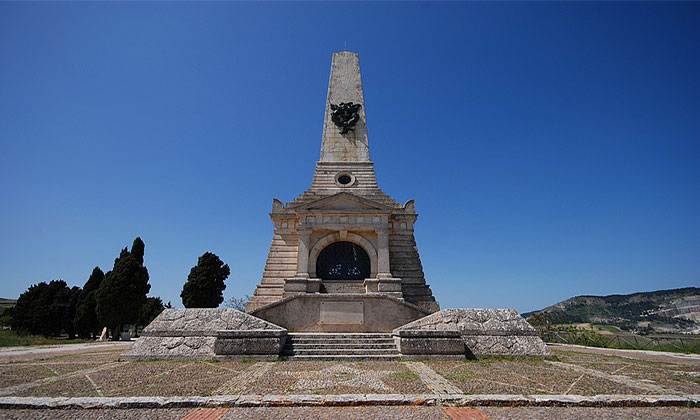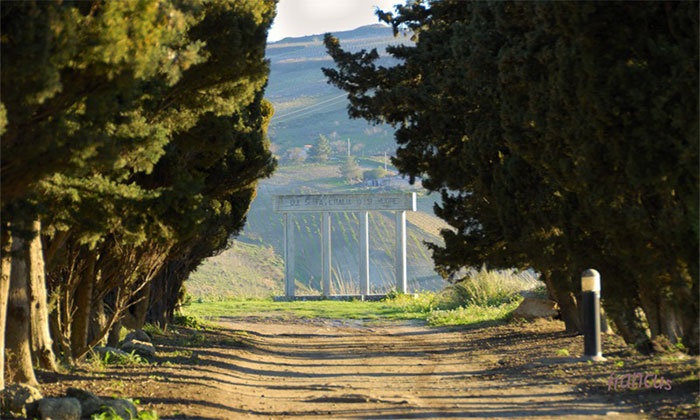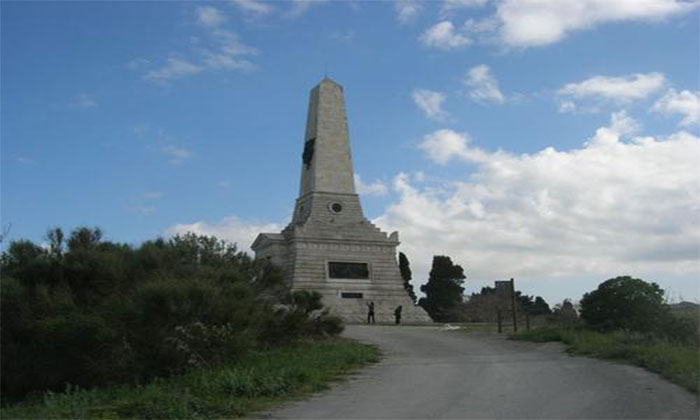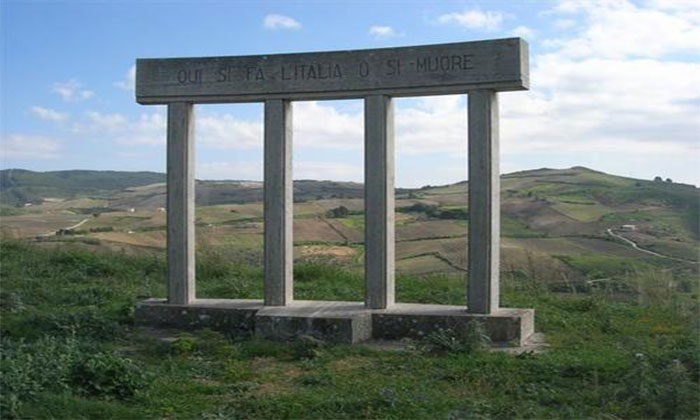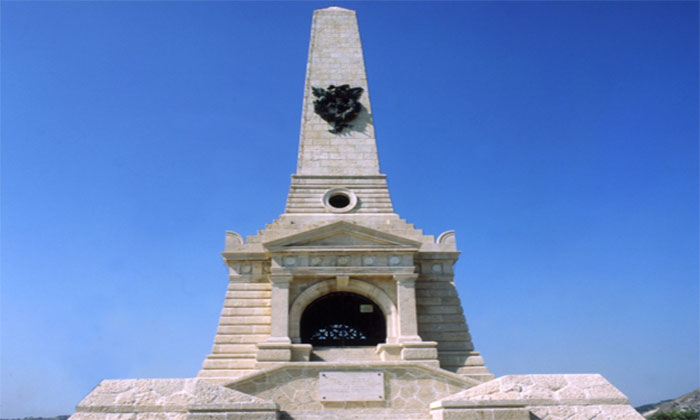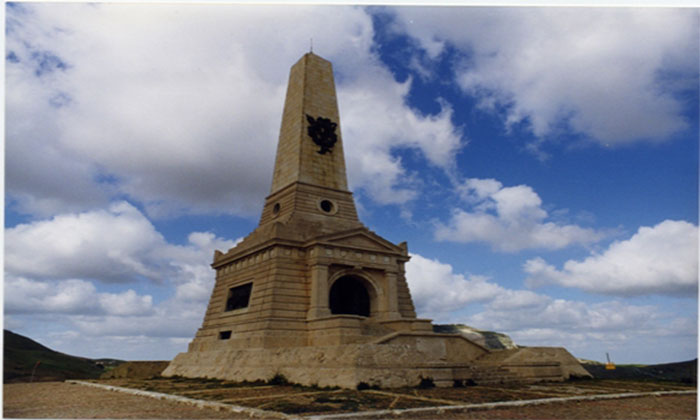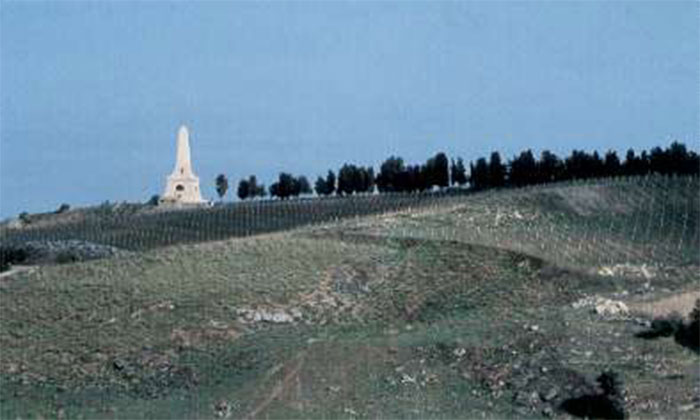Info Generiche
lat: 37°53’50.1″N
lng: 12°50’10.7″E
Itinerario Storia e Mito: 25°
Percorrendo la strada statale 113 che da Trapani conduce a Calatafimi Segesta, si giunge ad un bivio che porta al colle detto Pianto Romano, dove si erge l’omonimo “Ossario”.
Eretto su iniziativa dei cittadini di Calatafimi Segesta e su progetto dell’ architetto palermitano Ernesto Basile a custodia delle reliquie dei caduti nella fatidica giornata, della battaglia del 15 maggio 1860, che fu decisiva per le sorti della spedizione e dell’ unità nazionale.
Fu inaugurato il 15 maggio 1892 nella 32° ricorrenza del combattimento. Ha una struttura piramidale alta circa 33 metri, a base quadrata con mura sagomate di marmo,visibile anche a grande distanza, costruito con pietra calcarea di Alcamo. La decorano ai lati due gruppi bronzei, di Battista Tassara, raffiguranti lo sbarco dei Mille a Marsala e la battaglia di Calatafimi.
Per mezzo dei gradini prende piede un alto obelisco a conci, nella cui metà si intravede una corona di bronzo con la Trinacria e due palme. Per le scale si sale all’ Ossario, fra due pilastri che sostengono il frontone dorico e si entra nel sacrario che custodisce le reliquie dei Caduti: garibaldini e borbonici.
Alla fine del viale dei cipressi, Viale della Rimembranza, il 15 maggio 1960 è stata posta una stele, regalo della Regione Siciliana in occasione del centenario del combattimento, in essa sono scritte le famose parole che Garibaldi disse a Nino Bixio:”Qui si fa l’Italia o si muore”.
Il 15 maggio di ogni anno viene commemorata la storica battaglia a cura dell’Amministrazione comunale di Calatafimi Segesta, con la partecipazione di autorità locali e di altre provenienti da diversi comuni d’Italia, assieme alla partecipazione delle scuole di Calatafimi Segesta e della comunità della Città stessa. Lì viene deposta una corona, per ricordare tutti i caduti della battaglia e celebrata la liturgia della parola con la benedizione dell’Ossario, eseguita da un presbitero o in certe occasioni anche dal Vescovo.
Importanti eventi sono stati organizzati nella città di Calatafimi Segesta in occasione del 150° Anniversario: emissioni dei francobolli della Battaglia di Calatafimi, mostre filateliche, concerti e rappresentazioni teatrali; ma particolare importanza ha avuto la storica visita del Presidente della Repubblica Giorgio Napolitano, venuto a rendere omaggio ai giovani eroi dei Mille e alla Città stessa, nel giorno dell’11 maggio 2010 nel luogo dove, 150 anni prima, la Bandiera Italiana veniva issata a conclusione della celebre battaglia che aprì le porte all’Unità d’Italia.
PIANTO ROMANO
Along the state road 113 that leads from Trapani to Calatafimi Segesta, you reach a junction leading to the hill called Pianto Romano, where stands the homonymous “Ossario”.
Erected by the citizens of Calatafimi Segesta and designed by the Palermo architect Ernesto Basile to guard the relics of the fallen on the fateful day of the battle of May 15, 1860, which was decisive for the fate of the expedition and national unity.
It was inaugurated on May 15, 1892 in the 32nd anniversary of the fight. It has a pyramid structure about 33 meters high, with a square base with shaped walls of marble, visible even at a great distance, built with limestone of Alcamo. On the sides there are two bronze groups, by Battista Tassara, depicting the landing of the Thousand in Marsala and the battle of Calatafimi.
Through the steps a tall obelisk in ashlars takes hold, in the middle of which there is a bronze crown with the Trinacria and two palms. On the stairs you go up to the Ossuary, between two pillars that support the Doric pediment and you enter the shrine that houses the relics of the Fallen: Garibaldi and Bourbons.
At the end of the avenue of cypresses, Viale della Rimembranza, on May 15th 1960 a stele was placed, a gift from the Sicilian Region on the centenary of the fight, in which are written the famous words that Garibaldi said to Nino Bixio: “Here you do Italy or die “.
On May 15 each year the historic battle is commemorated by the municipal administration of Calatafimi Segesta, with the participation of local authorities and others from different Italian municipalities, together with the participation of the schools of Calatafimi Segesta and the community of City itself. There is placed a crown, to remember all the fallen of the battle and celebrated the liturgy of the word with the blessing of the Ossuary, performed by a presbyter or on certain occasions also by the Bishop.
Important events were organized in the city of Calatafimi Segesta on the occasion of the 150th Anniversary: issues of the stamps of the Battle of Calatafimi, philatelic exhibitions, concerts and theatrical performances; but the historic visit of the President of the Republic Giorgio Napolitano, who came to pay homage to the young heroes of the Thousand and to the City itself, was particularly important on the day of 11 May 2010 in the place where, 150 years earlier, the Italian flag was hoisted conclusion of the famous battle that opened the doors to the unification of Italy.
PIANTO ROMANO
Le long de la route nationale 113 qui mène de Trapani à Calatafimi Segesta, vous atteignez une jonction menant à la colline appelée Pianto Romano, où se trouve l’homonyme “Ossario”.
Construit à l’initiative des citoyens de Calatafimi Segesta et sur le projet de l’architecte Ernesto Basile de Palerme à la garde des reliques de ceux qui sont morts ce jour fatidique, la bataille du 15 mai 1860, qui a été décisive pour le sort de l’expédition et de «l’unité nationale.
Il a été inauguré le 15 mai 1892 à l’occasion du 32e anniversaire du combat. Il a une structure pyramidale d’environ 33 mètres de haut, avec une base carrée avec des murs en forme de marbre, visible même à une grande distance, construit avec du calcaire d’Alcamo. Sur les côtés, il y a deux groupes de bronze, de Battista Tassara, représentant le débarquement des Mille à Marsala et la bataille de Calatafimi.
A travers les marches, un grand obélisque en pierres de taille s’empare, au milieu duquel se trouve une couronne de bronze avec la Trinacria et deux palmiers. Dans l’escalier, vous montez à l’ossuaire, entre deux piliers qui soutiennent le fronton dorique et vous entrez dans le sanctuaire qui abrite les reliques des morts: Garibaldi et Bourbons.
A la fin de l’avenue des cyprès, l’avenue du Souvenir, le 15 mai 1960 a été placée un Stèle, don de la région de Sicile à l’occasion du centenaire de combat, dans ses célèbres mots que Garibaldi sont écrites dit Nino Bixio: « Ici, il y a Italie ou mourir “.
Le 15 mai de chaque année est commémoré la bataille historique de la ville administration de Calatafimi Segesta, avec la participation des autorités locales et d’autres de différentes villes d’Italie, ainsi que la participation des écoles de Calatafimi Segesta et la communauté La ville elle-même. On y a placé une couronne pour se souvenir de tous les soldats tombés au combat et célébré la liturgie de la parole avec la bénédiction de l’Ossuaire, exécutée par un prêtre ou à certaines occasions également par l’évêque.
Des événements importants ont été organisés dans la ville de Calatafimi Segesta à l’occasion du 150e anniversaire: émissions des timbres de la bataille de Calatafimi, expositions philatéliques, concerts et représentations théâtrales; mais était particulièrement important de la visite historique du Président de la République Giorgio Napolitano, est venu rendre hommage aux jeunes héros des Mille et de la même ville, dans la journée du 11 mai 2010 sur le site où, il y a 150 ans, le drapeau italien a été hissée conclusion de la célèbre bataille qui a ouvert les portes à l’unification de l’Italie.

